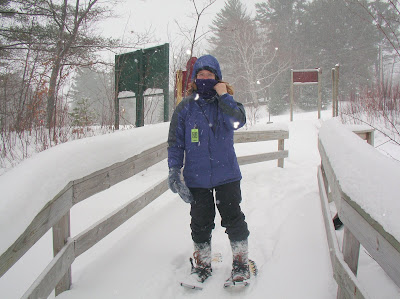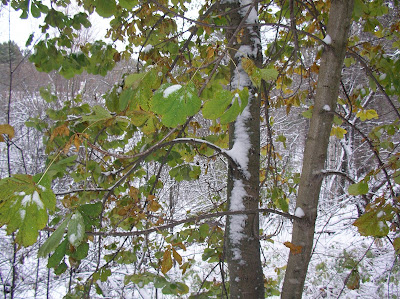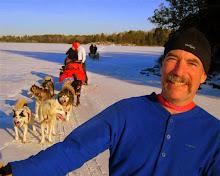When my wife Lynn and I moved from Homer in south central Alaska to Eagle on the Upper Yukon to teach. We rented a little frame cabin for our first winter.The cabin was on the edge of town, had a great place for keeping the dog team and an old house trailer for storage. Secure storage for food and other supplies is a necessity in the north, in remote areas where you don't have store access to supplies. Eagle had a couple of stores where canned goods and the basics could be got... for a price, but we enjoyed home made food instead of the fare usually offered in small stores in the bush.
The rental cabin had a small oil heater in it but we were into heating with wood. My father had crated and sent up, as a Christmas present, an Ashley wood burning stove two years before. Lynn and I were then living together and beginning a life together at a rented log cabin 20 miles out of Fairbanks on Chena Hot Springs Road while she finished up getting a teaching certificate.
The cabin at Eagle that we were renting didn't have electricity so the electric blower on the Ashley stove was of no use to us. Not bad, we were thinking.. We wanted to sharpen life down to the essentials, live elementally without most of the conveniences that were always taken for granted in our childhoods. Eagle was the kind of place that is a walkable community and many people didn't own automobiles. We had an old pickup truck and a decrepit Volkswagen Beetle. When the snow came that year, both vehicles were parked for the winter, covered deeply in snow as the winter progressed. We had freighted in staple foods for ourselves and dog food for the dozen huskies that I had been raising , training and transporting from place to place since I started dog mushing in Anaktuvuk Pass. I still had my chainsaw from my days of heating and cooking with wood in the Upper Peninsula of Michigan. I hadn't had electricity even then and still had a couple kerosene lamps that would be of use in Eagle. Now I was back into the type of life that I had enjoyed then, except now I was married and sharing this life with a woman who was as excited as me about living the almost- pioneer life.We were both looking forward to the dog team getting regular use for transportation as well as hauling water and wood.
The Eagle City Well House, built in the end of the 19th century, was still in use by most of the town. Water was still pumped by the wind mill into the large redwood tank up above the hand dug well.Most people didn't have indoor plumbing and used outhouses.
My parents came up to Alaska for a visit and my father helped us move our belongings to the rental cabin. My parents were enchanted with Eagle, though my mother was not too keen on living like a pioneer. When we moved in and started school teaching we were very busy but life was full and fun. Cutting wood on Signal Tower Hill on the weekend, shooting grouse, and setting up housekeeping kept us busy. Meeting all kinds of characters in the town and out on the country, fitting into the school scene in Eagle and running the dogs out to the school, three miles from the town, this was the rhythm of our lives. The river people, young live-off-the-landers were in their heyday then. Dick Cook, Charlie Edwards, Monty Warner and a host of others were all visiting Eagle to pick up their mail and supplies before going out to their cabins and trap lines for the winter. Charlie Edwards became a good friend to me in the first year. He came around bearing gifts of salmon and then in the early winter he and I mushed out into the Seventy Mile River country, my first time traversing the trails up Boulder Creek.
By the time the spring was coming we had decided to get some land and stay in Eagle. With Dale Richert's help we found a couple of city lots for sale on the buffer zone at the edge of town. The lots were on the side hill with no access except a trace up along the city line. We would have a decent cabin site , place for a garden and the dogs could reside just over the property line in the buffer zone. I ordered a tent from Alaska Tent and Tarp, we put it on Charlie Edwards' lots in town while there was still a couple feet of snow on the ground. We had moved out of our rental cabin because, after all, we could buy the wall tent with a month's rent saved and we also wanted to live in the tent in the spring. Lynn had gotten together a high school trip to Britain, on an airline special where we could fly into London for less than a flight to Seattle. We left the tent for a 3 week period for the trip. When we came back the snow was gone and we were putting any spare moments into prepping the site for a garden and figuring out our cabin. The wall tent was a cozy abode for us with its little Yukon stove and a pole bed. The multitude of warblers and nesting robins made the woods alive with morning cheer.
We got 8 foot 2-sided cabin logs and vertical studs ordered from Mike Potts, a local trapper, homesteader and logger. We took a promising art student from Eagle Village, Howard David, with us down to Homer for a few weeks where he got instruction from a local artist, Gary Lyons. I brought Howard back to the Eagle Village, leaving Lynn in Homer for a few weeks longer while I started work on the cabin.
I was amazed that my sweet mate's garden that she had planted before we left for Homer was not only sprouted but was flourishing with no human care. Getting the logs and materials to the cabin site was accomplished with the help of John Borg, who had a large wagon and bulldozer. John also pushed out a level pad, as our plan was for a cabin that was earth bermed on 3 sides to better insulate from the cold. It tended to rain every afternoon and this watered the garden but also made building in the woods a wet misery filled with mosquitoes.
Gary Lyons had given us a log building book that had a chapter about piece en piece log building, a French Canadian method. With the materials at hand, this became our building method of choice. The building went forward. We moved in with the snow flying, still putting in windows and a door.
We had a small cast iron Vermont Castings Resolute wood stove and a wood cook stove that was in a warehouse of the Eagle Commercial Co. Lynn went into Fairbanks for building materials with the truck and surprised me by bringing back a hardwood freight racing sled that would be capacious for everything: laundry, water, wood and our first child. Lynn was pregnant! We moved up the dogs and tent and settled in for the winter. One acquaintance, Steve Nelson, said that he heard me that first winter, cutting wood with the chainsaw at night to heat the cabin. The little wood stove often had to run cherry red to heat our place in the far below zero weather. The manufacturer must have figured heated square footage based on a well insulated house in a temperate climate, not the sub Arctic. With both the wood heat and cook stoves going the cabin was extra toasty. Lynn was on a different schedule at the school. She was half-time so came back and would get the stoves going and heat the cabin as well as get food and dog food on before I got back in the late afternoon. I made a little plank komatik for her so she could mush out to the school with 3 dogs pulling her. She could sit on the low basket and be comfortable and safe. As she got larger she was concerned that she might fall off a basket sled while standing up.
As far as being out on the land in winter, both of us were well used to temperatures of 60 below and Lynn was a good seamstress of mukluks, moccasins and parkas. I had my arctic gear from living with the Inuit above the Arctic Circle.
In later years we added a porch and then a log arctic entryway on the porch to our little cabin. The wall tent gradually rotted away from the bottom up and was discarded in favor of a large two story shop. A log sauna was put in just a couple of steps below the cabin and our three kids that came along soon after the cabin was built were all used to taking their bath in the sauna. We lived in our cabin for seven years and then moved into our large log home, but that is another story.

Here is our south side of the earth bermed cabin with the earth bermed up 4 feet. You can see the vertical studs on the corner and at 8 feet in the middle of the wall. The studs had a spline that the horizontal logs could slide on as the logs will shrink and expand a bit based on temperature and humidity, so the ability for them to slide upon the spline will allow them to stay tight against each other so that air will not infiltrate between each log. We put in the gambrel or barn roof so that the upstairs would have a short pony wall and thereby have a full upstairs - important in a 16 x 16 foot cabin with, eventually, 2 adults and 2 children were living and sleeping there! The oil barrel at the corner of the cabin was a new convenience by the people who bought our cabin from us. After we moved out of the cabin we had electricity put in when it was available so that renters could have this convenience.

This is the view from the dog yard of the cabin and sauna. The people who bought the cabin added the little room on the left end of the porch for their computer room and put on the ugly steel door on the outside arctic entryway. They also quit using the sauna for what it was built for; now it is a storage cache, complete with blue tarp on the roof. I don't know what became of the green steel that used to be on the roof. The spruce trees that sheltered the sauna are log gone.
The walls of the sauna were saddle notched and long-log-scribed for tightness. Many a relaxing evening were enjoyed in our sauna. The kids knew only the sauna as their bathing apparatus. Sometimes they would get too hot in their wash tub so we would step out onto the little porch with overhanging snow covered spruce branches and shake a branch, sending a frigid dusting of powder onto our steaming bodies! Then we would rush back into the sauna to get warm again.



































